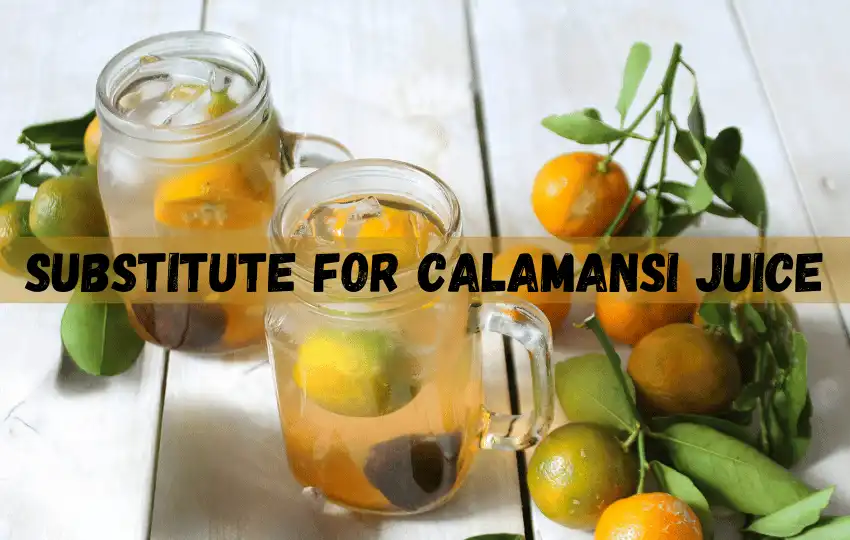Calamansi juice is a popular ingredient in Filipino cuisine, used for its tangy, sour taste and distinctive aroma.
It’s a key ingredient in many dishes, especially in marinades, dipping sauces, and drinks.
However, finding calamansi juice can be difficult outside of Southeast Asia, and it can be pricey when you do find it.
But don’t worry; there are plenty of substitutes for calamansi juice that you can use in your cooking.
In this post, we’ll share the 12 best substitutes for calamansi juice with ratios and how to use them.
In short, " What can I use instead of calamansi juice?" Lime Juice, Lemon Juice, Vinegar, Tamarind Paste, Yuzu Juice, Grapefruit Juice, Orange Juice, Tangerine Juice, Sumo Citrus, Pomelo Juice, and Cranberry Juice.
What is calamansi juice, and what does calamansi juice taste like?
Calamansi juice is a citrus beverage made from the juice of calamansi, a small citrus fruit native to Southeast Asia. It is widely consumed in the Philippines and other tropical regions where calamansi trees thrive.
Calamansi juice is a refreshing and popular drink that can relish on its own or used as an ingredient in various recipes.
Calamansi fruit is about the size of a key lime, with a thin, bright orange skin and juicy flesh.
When the fruit is squeezed, it yields a tart and tangy juice that is prized for its unique flavor.
The taste of calamansi juice can be described as a combination of sourness, sweetness, and a hint of bitterness.
The flavor profile of calamansi juice is often likened to a mix of lemon, lime, and tangerine.
It has a distinct citrusy acidity that is more mellow than lemon or lime juice, with a slightly sweeter and floral undertone. The balance between the sour and sweet notes creates a refreshing and thirst-quenching taste.
In addition to its flavor, calamansi juice is also appreciated for its aromatic fragrance, which adds to its appeal.
Calamansi juice is well-loved for its vibrant and tangy taste, making it a popular choice for those who enjoy citrus beverages with a unique twist.
Uses of calamansi juice
Calamansi juice is an incredibly versatile and flavorful beverage with a wide variety of uses.
From culinary applications to beauty treatments, this refreshing juice has played an important role in many cultures for centuries.
Culinary Uses: Calamansi juice is widely used in Southeast Asian cooking, particularly in Filipino cuisine. It can use to marinate meats and fish, as a flavoring for noodles and rice dishes, or even as a dressing for salads or desserts.
Calamansi juice adds a zesty, citrus flavor to any dish and can also help bring out the sweetness of other ingredients like onions or tomatoes.
Beauty Treatments: Calamansi juice is not only delicious, but it is also packed with skin-nourishing antioxidants that can support healthy skin.
Applying calamansi juice topically can reduce age spots and dark circles under the eyes. Additionally, its high vitamin C content helps boost collagen production, which promotes firmer skin and reduces wrinkles over time when applied regularly.
Health Benefits: Not only is calamansi juice packed with antioxidants and vitamins, but it also has antimicrobial properties due to its high acidity level that can help fight bacteria and viruses.
Rich in calcium, magnesium, phosphorous, iron, zinc, copper, and manganese – regular consumption of calamansi juice helps maintain strong bones and teeth while aiding metabolic processes like digestion.
It can also help reduce cholesterol levels if consumed regularly over time.
Where to buy calamansi juice?
If you are looking for calamansi juice where to buy, there are a few other places you can go. Many specialty food stores carry it, as do some international grocery stores.
You can also order online from many retailers that provide a variety of diverse flavors and types of calamansi juice.
The best substitute for calamansi juice
1. Lime Juice – A good substitute for calamansi juice
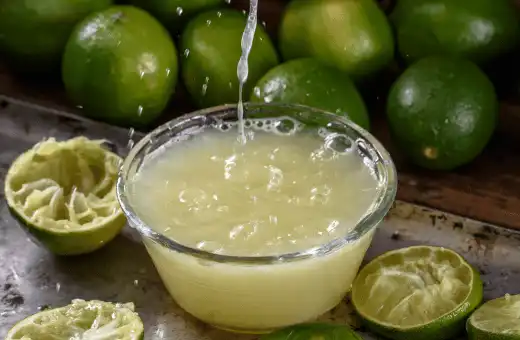
Lime juice is the most common substitute for calamansi juice, both in terms of flavor and availability.
It has a similar tangy, sour taste that makes it a great replacement in marinades, stews, and dips.
Ratio or measurement: To substitute for calamansi juice, use a 1:1 ratio of lime juice to calamansi juice.
For example, if a recipe requires 2 tablespoons of calamansi juice, use 2 tablespoons of lime juice instead.
2. Lemon Juice – similar to calamansi juice
Lemon juice is another good substitute for calamansi juice, but it has a stronger, more tart flavor than lime juice.
Ratio or measurement: Use a 1:1 ratio of lemon juice to calamansi juice, and adjust according to your taste preferences.
3. Try Vinegar instead of calamansi juice
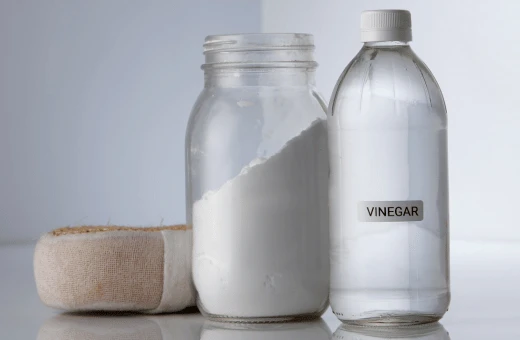
For a stronger sour flavor, you can substitute vinegar for calamansi juice. Use white or rice vinegar as the closest replacement since they have a similar acidity level as calamansi juice.
Ratio or measurement: Use a 1:1 ratio of vinegar to calamansi juice, adding more or less to taste.
4. Tamarind Paste – similar to calamansi juice
Tamarind paste has a sour, fruity taste that’s similar to calamansi juice, and it’s commonly used in Southeast Asian cuisine.
Ratio or measurement: To substitute for calamansi juice, use a 1:2 ratio of tamarind paste to water, then adjust to your taste preferences.
For example, if a recipe requires 2 tablespoons of calamansi juice, use 1 tablespoon of tamarind paste mixed with 2 tablespoons of water.
5. Yuzu Juice – a great alternative to calamansi juice
Yuzu juice is a citrus fruit popular in Japanese cuisine, and it has a tart, tangy flavor that’s similar to calamansi juice.
It can be hard to locate outside of Japan, but you can sometimes find bottled yuzu juice in specialty stores or online.
Ratio or measurement: Use a 1:1 ratio of yuzu juice to calamansi juice, and adjust to your taste preferences.
6. Grapefruit Juice – similar to calamansi juice

If you’re looking for a slightly sweeter substitute for calamansi juice, grapefruit juice can work well.
It has a more mellow, less tart flavor than other citrus fruits but still adds a nice zing to recipes.
Ratio or measurement: Use a 1:1 ratio of grapefruit juice to calamansi juice, and adjust to your taste preferences.
7. Use Orange Juice to replace calamansi juice
Orange juice is another good substitute for calamansi juice in recipes that call for a sweeter taste. It has a mild, sweet flavor that complements the sourness of other ingredients.
Ratio or measurement: Use a 1:1 ratio of orange juice to calamansi juice, and adjust to your taste preferences.
8. Kalamansi Flavoring – A tasty replacement for calamansi juice
If you can’t find fresh calamansi juice or any of the above substitutes, you can try using kalamansi flavoring instead.
It’s a concentrated, artificial flavoring that’s used in many Filipino recipes. Follow the written instructions on the packaging for how much to use.
9. Tangerine Juice – similar to calamansi juice
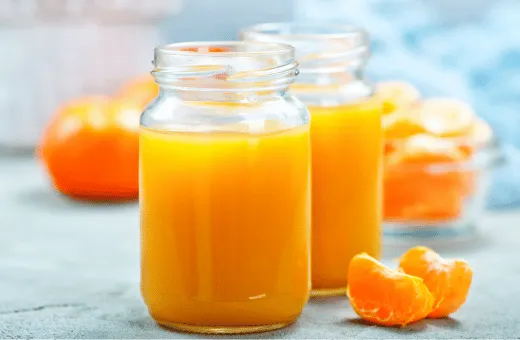
If you prefer something less sour but still fruity, tangerine is another good option.
Ratio or measurement: Using one cup of tangerine per 4 cups required bamboo shoot soup ingredients like ampalaya leaf or kangkong stem will help give the soup more layers of flavor (and calcium!).
Finally, adding stir-fried ground pork or beef will add protein content while enhancing texture and taste – making this soup even heartier!
10. Sumo Citrus – A good substitute for calamansi juice
Sumo citrus is a hybrid of two different citrus fruits, pomelo and mandarin orange, which makes it perfect for adding that sweet-tart flavor profile to any dish you’re making.
Ratio or measurement: Just use one cup of sumo citrus per 4 cups of required calamansi juice and enjoy the added depth of flavor!
11. Pomelo Juice – similar to calamansi juice
If you’re looking for a substitute that packs more of a punch, pomelo is the way to go – it’s super tart and also slightly sweet, making it an ideal sub for calamansi!
Ratio or measurement: The ratio is 1 cup of pomelo per 4 cups required calamansi juice; just make sure to adjust the sweetness as needed depending on how sweet you want your food or drink to taste.
12. Cranberry Juice –A decent substitute for calamansi juice
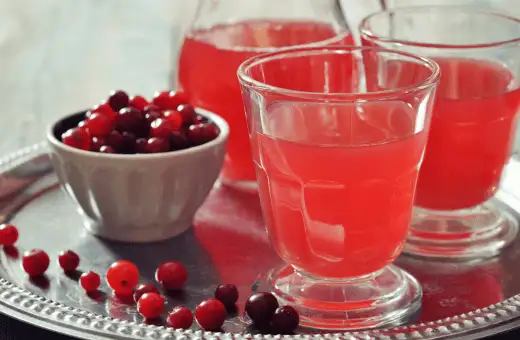
Last but not least, cranberry juice can be used to add that tangy flavor in place of calamansi.
Ratio or measurement: Use 1 cup of cranberry juice per 4 cups of required calamansi and enjoy its sweet-tart taste!
Again, adjust the sugar levels depending on how sweet you want your dish to be.
Substitute calamansi juice in baking
When baking, a suitable substitute for calamansi juice is lemon juice. This citrus fruit has a tart flavor and can be used to add brightness and acidity to recipes.
Lemon juice can be found in most grocery stores, either fresh or bottled juice. However, if the unique flavor of calamansi is desired, a concentrated form is available online.
To substitute, use two tablespoons of lemon juice for every tablespoon of calamansi juice called for in the recipe.
For example, if a recipe requires 1/4 cup of calamansi juice, use 1/2 cup of lemon juice instead. The same ratio applies when swapping out other measurements, such as teaspoons and milliliters.
Lemon zest can also be used to replace some of the sourness from the missing calamansi juice in baked goods like cakes and muffins.
Simply use one teaspoon of grated lemon zest per each tablespoon of calamansi called for in the recipe.
Additionally, adding a teaspoon or so of sugar can help with balancing out any tartness from the added citrus zest.
How to Choose the Most Suitable Substitution Option for calamansi juice
When selecting a suitable substitution option for calamansi juice, consider the following tips:
1. Taste and Flavor Profile: Consider the flavor profile you desire to replicate. Pay attention to the specific taste notes of calamansi, such as its unique combination of sourness, sweetness, and floral undertones.
Look for a substitute that can offer a similar flavor experience.
2. Acidity Level: Calamansi is known for its acidic taste. If acidity is a crucial element in the recipe or application, choose a substitute with a comparable level of acidity to achieve the desired balance in your dish or beverage.
3. Citrus Substitutes: Since calamansi is a citrus fruit, you can explore other citrus fruits as potential alternatives.
Lemon, lime, or a combination of both can be used to provide a tangy and citrusy flavor similar to calamansi.
4. Proportions and Ratios: Experiment with different proportions and ratios when substituting calamansi juice.
Start with smaller amounts and gradually adjust to achieve the desired level of tartness and sweetness in your recipe.
5. Availability and Accessibility: Consider the availability and accessibility of the substitute option.
Opt for alternatives that are readily accessible in your location or can be easily obtained from local grocery stores or markets.
6. Natural vs. Artificial Substitutes: Decide whether you prefer natural substitutes or are open to using artificial flavors or concentrates.
Natural alternatives may include freshly squeezed citrus juices, while artificial options can come in the form of concentrates or flavorings.
7. Recipe Adaptation: Be prepared to adapt your recipe or application to accommodate the chosen substitute.
Since flavors may vary, adjustments to other ingredients or seasonings might be necessary to achieve the desired overall taste.
8. Experimentation and Taste Testing: It’s important to experiment and taste-test the substitute option in your specific recipe or application.
This permits you to assess how well it complements the other ingredients and whether it successfully replicates the flavor profile of calamansi.
Discover more: Best Substitutes for Pickle Juice & way to use
Conclusion on substitute for calamansi juice
In conclusion, while calamansi juice is an essential ingredient in many Filipino recipes, there are plenty of substitutes available that can work just as well.
By experimenting with different ratios and flavors, you may even end up with new flavor combinations that you love.
So, next time you can’t find calamansi juice, don’t worry – just use one of these 12 substitutes instead.
FAQs on substitute for calamansi juice
Q1. What is similar to calamansi juice?
Similar to calamansi juice are other citrus juices such as lemon, lime, orange and grapefruit. These juices can all be used in various recipes or added to other beverages for flavor.
Additionally, tangerine juice is often used as a substitute for calamansi juice due to its similarly tart flavor profile.
Q2. Can I replace lemon juice with calamansi?
Yes, you can replace lemon juice with calamansi in many recipes. Calamansi, also called calamondin or Philippine lime, is a small citrus fruit that’s native to the Philippines.
It has a sweet-tart flavor and aroma with hints of sour orange and mandarin, and it is often used as a choice for lemon juice due to its similar acidity.
The juice from one calamansi is equivalent to about one teaspoon of lemon juice, so you would need to use more if replacing larger amounts of lemon juice in a recipe.
Calamansi adds sourness and sweetness to dishes without overpowering them like regular lemon can, making it perfect for sauces, dressings and marinades. You can also utilize it in baking recipes like cakes and muffins for an extra zesty kick!
Q3. Can I use vinegar as a replacement for calamansi?
Yes, you can use vinegar as a substitute for calamansi. Vinegar has a similar tart and acidic flavor that can be used to replace the flavor of calamansi.
You may require to modify the amount of vinegar depending on your recipe, but generally, 1 tablespoon of white or apple cider vinegar is equivalent to 1 tablespoon of fresh calamansi juice.
Q4. How many calamansi in half a lemon?
The exact amount of calamansi in a half lemon. Generally, a half lemon can contain anywhere from 3 to 6 calamansi, depending on its size.
Calamansi is small citrus fruits, typically around 1 inch or 2.5 centimeters in diameter and have an acidic flavor. They are prized for their tart taste and can use as a substitute for lime in drinks and recipes.
When using them, it’s good to remember that they are generally more sour than lemons, so you may require to adjust the proportions of other ingredients accordingly.
Q5. Can I substitute calamansi juice for lemon juice?
Calamansi juice is a great substitute for lemon juice, although it has a slightly different flavor profile. Calamansi juice is an excellent source of vitamin C, having around 4 times more than lemon juice.
Additionally, calamansi juice has a slightly more tart and acidic flavor and a surprisingly sweet aftertaste.
It can use in many recipes that call for lemon juice, including marinades, sauces, drinks like lemonade or margaritas, and even desserts such as cakes or pies.
However, suppose you want to replicate the exact same flavor as lemon juice. In that case, you may require to adjust the amount used and/or add a small amount of sugar to sweeten the tartness of the calamansi juice.

